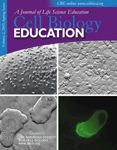Cancer Cell Biology: A Student-Centered Instructional Module Exploring the Use of Multimedia to Enrich Interactive, Constructivist Learning of Science
Abstract
Multimedia has the potential of providing bioscience education novel learning environments and pedagogy applications to foster student interest, involve students in the research process, advance critical thinking/problem-solving skills, and develop conceptual understanding of biological topics. Cancer Cell Biology, an interactive, multimedia, problem-based module, focuses on how mutations in protooncogenes and tumor suppressor genes can lead to uncontrolled cell proliferation by engaging students as research scientists/physicians with the task of diagnosing the molecular basis of tumor growth for a group of patients. The process of constructing the module, which was guided by scientist and student feedback/responses, is described. The completed module and insights gained from its development are presented as a potential “multimedia pedagogy” for the development of other multimedia science learning environments.
INTRODUCTION
Multimedia-based learning is increasingly present in highereducation courses, be they on-line, videoconferenced, or traditional face-to-face. Broadly viewed, multimedia can include animations, simulations, tutorials, drill and practice questions/answers, and problem-based modules. Though the educational benefits of multimedia in learning continue to be debated (see review by Clark, 2001), the coevolution of information and communication technologies with teaching and learning methods (Halyard and Pridmore, 2000) presents unique opportunities for multimedia to have a profound impact upon teaching and learning.
Multimedia is becoming an important tool for faculty in the biological sciences due to increasing conceptual and functional complexity that presents educational challenges that cannot be adequately addressed with traditional teaching methods (Buckley et al., 1999). Further, multimedia-based laboratory modules allow students to conduct experiments and experience interactive learning that would otherwise not be possible due to the complexity of the topic, laboratory hazards, cost, and/or ethical dilemmas; for example, at the undergraduate level, computer simulations have replaced some dissection laboratories (Watanabe, 2002). For educating medical and health professionals, many schools have explored drill and practice training (Boudinot and Martin, 2001; Wilson and Mires, 2001) and problem-based modules (Kennedy et al., 2001; Keppell et al., 2001) as ways to improve learning. Recently, multimedia has been utilized to allow students to control real laboratory equipment from a distance, for example, scanning probe microscopes (Razdan et al., 2000) and chemical reactions (Senese et al., 2000). In general, though, lab-based multimedia such as tutorials, simulations, and problem-based modules have been used to supplement traditional laboratories and provide “hands-on” opportunities in courses where laboratories are not feasible, such as in distance education courses.
Given the variety of multimedia tools and design possibilities, there are a number of ways to design instructional multimedia to advance learning. Many principles have been identified for effective learning and overall design, including instructional, interactive, interface, and usability design (Brittain et al., 1998; Gagné et al., 1992; Graham, 1999; Head, 1999; Hunt, 1998; Lavoie, 1995; Lee and Owens, 2000; Mandel, 1997; Mayer, 2002; Soulier, 1988). Here we describe the design and development of Cancer Cell Biology (West and Bockholt, 2000, 2002), an interactive multimedia, problem-based module with the goal of bridging concepts between basic experimental techniques and underlying factors that govern the cell biological principles involved in the development of cancer.
TOPIC, MODULE, PEDAGOGY, AND TECHNICAL DESIGNS
Four design components guided the creation of Cancer Cell Biology, along with focus-group feedback; the design components are considered first.
Topic Design
In developing a module, we wanted to identify a topic that was conceptually challenging and relevant to pique student interest. Oncogenesis, which encompasses the disciplines of cell biology, molecular biology, and genetics, was selected because it is an integrated field and because it is a disease state that directly or indirectly touches us all. Further, cancer exemplifies the importance of maintaining the complex interactions of biological systems and readily illustrates the ramifications if altered.
Cancer arises from a series of mutations in genes that regulate normal cell behavior. The classical example is mutations in tumor suppressor genes and protooncogenes, which result in the disruption of normal cell cycle regulation, giving rise to uncontrolled cell growth. Given the general understanding of the impact of these mutations, they were selected to be the focus of this cancer module. The overall objective is for students to relate concepts of how cells behave in different assays with basic concepts of what is occurring at the molecular level to lead to the development of cancer. Specifically, the educational objectives are for students to be able 1) to gather data from five basic assays as needed, including Western blot, immunofluorescence staining, protein inhibition, gene transfer, and apoptosis; 2) to distinguish between oncogenes and tumor suppressor genes; 3) to identify the location of the mutation in either the coding or the regulatory regions of a gene; 4) to identify the function of a particular protein; and 5) to describe how the mutation of a gene results in changes in the function of its protein and, ultimately, cell behavior. The goal was to design a module to address these objectives and experimental techniques that could be completed in about an hour, depending upon a student's background. Thus, it was necessary to limit and greatly simplify the problem to the analysis of a single-gene mutation in either a protooncogene or a tumor suppressor gene involved in tumor cell growth.
Module Design
Scientific research involves the analysis of experimental evidence from multiple sources, including data from experiments performed in the laboratory and scientific publications. Through a process of hypothesis formulation and testing, a scientist is able to develop an explanation for an observed phenomenon. How this discovery process unfolds varies with a scientist's training and knowledge base. For example, different scientists often discover the same gene or protein beginning with different hypotheses and/or employing different experimental approaches. Multimedia presents an opportunity to place large numbers of students intellectually in the world of scientific research so they can experience and learn from the scientific process in a manner that best suits their learning styles.
Cancer Cell Biology places the student in the role of a physician/scientist with research tools to conduct experiments with the goal of identifying the mutated gene responsible for tumor cell growth in a patient. Students begin by entering their last name on the module's welcome page, which results in their being addressed throughout the module as“ doctor (last name).” After choosing one of four fictitious patient cases, the student is presented with a letter containing a patient description and medical history (Figure 1). In each case, the letter also explains that the patient has had a benign tumor removed and requests the expertise of the doctor in 1) identifying which one of six protooncogenes and tumor suppressor genes (A to F) is mutated, 2) determining where the mutation is likely to have occurred, i.e., in the regulatory or coding region, and 3) identifying the function of the protein that the gene encodes. Using both tumor and control cells isolated from the patient, the doctor can employ five experimental assays to characterize the mutated gene and its protein. Figure 2 illustrates the gene transfer assay (Figure 2A) along with sample student results (Figure 2B). As needed, the doctor accesses background information on each assay (Figure 2C), as well as a short review on protooncogenes and tumor suppressor genes (Figure 3A). A pop-up window accessed by the Notes button enables students to record notes throughout the analysis process. Students are encouraged to use these notes to identify the mutated gene and complete a final report on the patient.
The report is a disguised evaluation of a student's conceptual understanding and mastery of content. The first set of questions, which is the same in all four cases, requires students to identify and characterize the mutated gene and the function of its protein product (Figure 4A). Correctly answering all three questions advances the doctor to a second set of questions, which are case-specific and further probe the doctor's understanding of the case (Figure 4B). If the submitted answers on either set are incorrect, the doctor is referred back to several experiments and is encouraged to try again (see example in Figure 5A). Upon successful completion of the report, the doctor is congratulated and provided a detailed analysis of the case for comparison with how his/her own diagnosis was reached (Figure 4C). The case ends with the student being invited to take on another case.
Student interactivity with the module relies upon the user interface and design of the learning elements. The simple student interface (see Figure 1) consists of a menu bar on the left side of the screen, which contains buttons to access the assays, notes, a review, and a patient list. All of the assay activities, background information, review, and feedback appear on the right side or in a pop-up window on the right side. The only button that is not located on the menu bar is the button for additional information on each assay, which is located in the upper-right corner of each assay screen (see Figure 2A). This design allows for nonlinear, yet intuitive, navigation and exploration of the module.
Figure 1. Screen shot of an introductory letter to the student, in the role of a doctor, received upon selecting a patient cancer case to investigate. The letter requests Dr. Smith's (student's last name) expertise in the identification and characterization of a mutated gene and its protein product and provides pertinent information for the investigation to begin. Left-hand margin buttons note the different assays available for investigating the patient case of Joe Garten and other elements for completing the case (see text).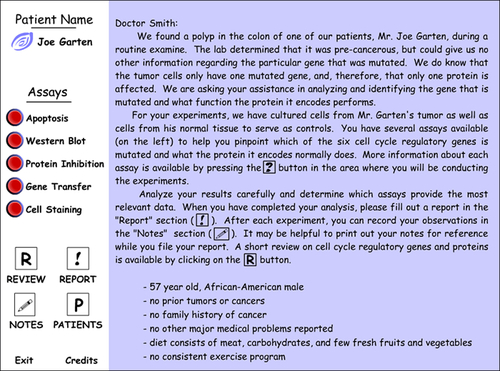
Pedagogy Design
Constructivist, or inquiry-based, learning (as reviewed by Leonard, 2000) served as the pedagogical model for developing the module. Specifically, the 5E instructional model (Engage, Explore, Explain, Elaborate, and Evaluate) is a series of phases facilitated by an instructor using defined strategies to elicit certain student behavior including engaging students with their peers to redefine, elaborate, and change their initial concepts through self-reflection (Bybee, 1997). This model is cyclical, student-centered, active, and inquiry-based. While the 5E model has been established as a desired pedagogy for science learning in the classroom and laboratory, its applications and efficacy in multimedia-based science learning environments are not well developed. The 5E model has been incorporated into the design of Cancer Cell Biology in the following ways:
Engage: To engage students, a topic must be relevant and the learning task defined. Cancer is a topic that students can relate to easily. The letter to the doctor (student) identifies the learning task and provides instructions for navigation. Further, this narrative creates interest by placing the student in the role of the expert doctor. To maintain student engagement, the module is nonlinear and interactive, enabling students to direct their own learning. Narratives are important for nonlinear multimedia, as they afford a productive student response by providing a goal and, upon completion, a sense of accomplishment (Laurillard et al., 2000).
Explore: The module's multimedia enabled, nonlinear design actively promotes student exploration and learning on an as-needed and as-desired basis. Students are free to choose one of four patients and then explore multiple experimental assays. As they make observations, formulate hypotheses, and test them, students begin to build their own understanding in ways that best suit them. Additionally, simplification of terminology at the beginning, e.g., genes named from A to F, minimizes students from being intimidated and discouraged by scientific jargon. Further, it forces students to work through the problem, rather than looking up answers for known genes. It also allows for more open-ended student discussion after students complete the cases by allowing them to relate the unknown genes to known genes.
Explain: Individually or in pairs, students delve into the content, terminology, and concepts to explain their observations. The module provides students access to background information on the experimental procedures being employed and how to interpret data. At this point, students incorporate new definitions and explanations and begin to put their understanding in their own words. Articulation of what is being learned is encouraged in this phase, which can be achieved through recording of thoughts and observations in the pop-up notes window or discussions with other students. The process of notetaking throughout the analysis of a case reinforces that the student is responsible for building knowledge (Laurillard et al., 2000). Further, providing the notes tool promotes record-keeping, a key function in the research process.
Elaborate: This phase requires that students begin making connections between concepts. To diagnose a patient's case successfully, higher-order thinking skills are required to evaluate multiple data and bring together the isolated concepts from the experimental assays and content available. Further, elaboration of the student's understanding can take place on another level as the student evaluates multiple patients with different characteristics. In essence, creative repetition reinforces concepts and skills.
Evaluate: Once students have connected concepts and have analyzed and evaluated the data in a case, they are ready to assess their understanding. Here is where a multimedia, computer-based medium can excel, enabling students to assess their own understanding with immediate guided feedback. For the assessment, students file a report involving a set of questions as part of the diagnosis, which has been designed to minimize guessing as the means of achieving a correct diagnosis. In the report, multiple questions must be answered correctly together. Thus, the first set of questions presents the student a 1-in-72 chance of guessing the correct answer, and the second set, a 1-in-27 chance. Further, the guided feedback encourages students to reevaluate their analysis and data interpretation by directing them back to experiments, which effectively makes use of cyclical (repetitive) learning to keep students on track to complete the problem-solving process. Finally, the congratulatory screen containing the correct interpretation and analysis provides students an additional opportunity to evaluate their findings, especially for those students who reached the diagnosis by some degree of guessing.
Figure 2. Screen shots of the components of an experimental assay the“ doctor” can use to gather data. (A) Shot of the gene transfer experiment. (B) Shot of the doctor's experiment transferring gene C and analyzing its effects on cell growth. (C) Shot of background information on the gene transfer experiment accessed via the question-mark button in the upper-right corner. All assays are designed the same way.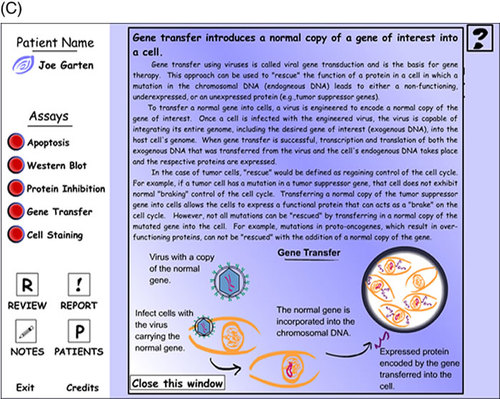
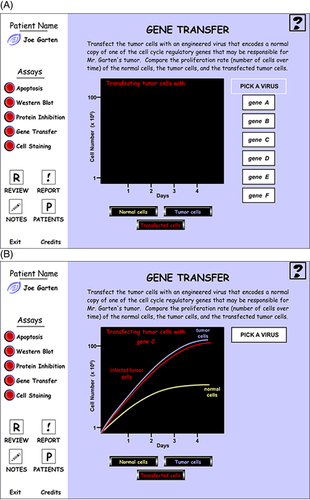
Concomitantly with the 5E model, we have strived to address successfully different student learning styles, e.g., sensing and intuitive, visual and verbal, sequential and global, and active and reflective, which require that dimensions of each learning style are addressed part of the time (Felder, 1993). For example, with Cancer Cell Biology, global learners can get an overview of the module and freedom to navigate to get an overall understanding, while sequential learners can use the module in a patient-by-patient and assay-by-assay format, providing them linear continuity in the learning process. Sensing learners like facts and observations, while intuitors like concepts and interpretations. Cancer Cell Biology requires that students exercise both styles of learning. We have tried to accommodate as many learning styles as possible, including the visual and verbal. Though audio capabilities are a strength of multimedia, Cancer Cell Biology is textual rather than audio-based because computers on campuses often do not have speakers, particularly those in libraries and computer labs. However, as more universities evolve from centralized computer lab support for students to mobile laptop-based environments (Chronicle of Higher Education, 2000), the use of audio will further enrich multimedia learning experiences for all students.
Technical Design
To promote accessibility, Cancer Cell Biology was developed as a Web-based module. Consequently, fast download times and multiplatform compatibility needed to be achieved, and this was possible using Macromedia's (2002a) Flash 4 software. Because Flash is a vector-based animation program, it produces small file sizes. Further, the Flash Player that is required to play the module in a Web browser has a high penetration rate, with 95.9% of users being able to use Flash 4 content without having to download and install a player (Macromedia, 2002b). In the event that a user does not have the correct version of Flash, the module directs them to the Macromedia site to download the most recent version.
FEEDBACK ON MODULE DESIGN
The development of Cancer Cell Biology was guided by feedback from scientist focus groups and undergraduate student discussions and surveys.
Scientist/Science Educator
Regular meetings were held with multidisciplinary groups of scientists and science educators to gather feedback on the topic, design, and construction of the module. Prior to students evaluating the completed module, several postdoctoral scientists also participated in providing feedback.
Undergraduate Students
Feedback was gathered formally from students participating in a survey and informally from other classes via discussion or written critiques. Here we describe the process in which feedback was formally solicited.
Figure 3. Screen shots depicting the development of the review pages on protooncogenes and tumor suppressor genes. (A) Shot of the single-page background information provided in the prerevision module. (B) Shot of the revised version of the review covering general information and concepts. (C) Shot of one of the expanded review pages accessed from the topic buttons across the top of the review.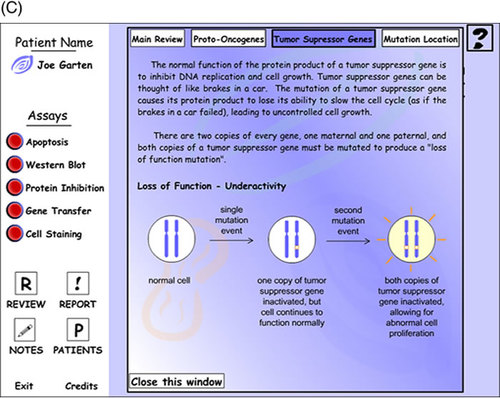
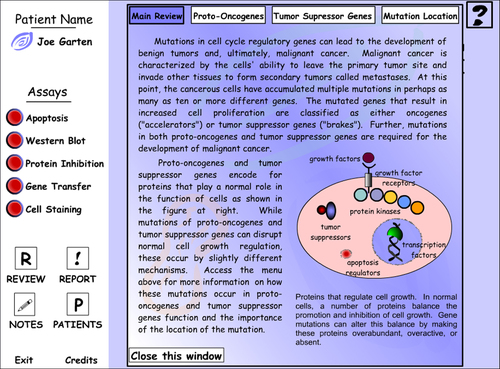
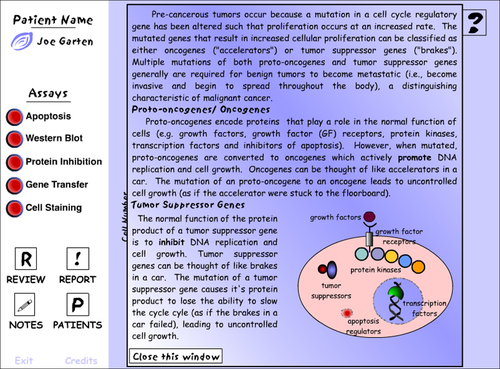
Prototype
A prototype of Cancer Cell Biology was piloted as part of a guest lecture series in a sophomore-level course near the end of the semester by two of the authors (Bockholt and West). The prototype consisted of a single patient case with only the first set of report questions. After an interactive lecture on cancer, students were given the module to explore over several days outside of class and the opportunity to write up and submit an analysis of the patient case for extra credit. In a subsequent class, the students completed a questionnaire and then discussed the module's content and goals (focus group format). The class ended with an interactive lecture on cancer treatments to achieve closure on the topic.
Complete Module
One year after the initial feedback in the same course, with Bockholt conducting the activity, the same process of an introductory interactive lecture to set students up for the module was followed by another interactive lecture and discussion session. Obtaining feedback from students involved a signed consent to participate. For extra credit in the course, students could either choose to participate in providing feedback via the survey or to complete an alternative activity that involved a set of problem-based questions on oncogenes and tumor suppressor genes to be submitted and provided feedback via e-mail. A Web page was used to provide instructions for completing either the Web-based module (West and Bockholt, 2000) and survey or the alternate assignment, with hyperlinks to each of these activities. Students were not told how many patient cases to investigate or how much time they were to spend on the module.
Survey Instrument
The on-line survey to gather student feedback included multiple-response and open-ended questions. The open-ended questions were designed to identify strengths and weaknesses in the module's design without biasing students. The survey was created using WebCT's quiz tool and students logged in with ID numbers and passwords. This on-line approach streamlined the survey process, facilitated review of student responses, and enabled students to report their experiences immediately after completing the module. To increase the likelihood of receiving completed surveys, this on-line survey tool alerted students to unanswered questions and provided the students an opportunity to complete the survey before finalizing their submission.
FEEDBACK FINDINGS
Prototype
Favorable student and instructor feedback on the prototype module, along with lessons learned by the authors, led to the next stage of development, which included 1) the addition of three patient cases, 2) the substitution of the analysis write-up with additional questions that probed students' in-depth understanding of a case; and 3) a model analysis of a case in the congratulatory message that students could compare with their own process of analysis.
Complete Module
Feedback on the completed module was obtained from 24 of 30 possible student participants—15 sophomores, 6 juniors, and 3 seniors. All of the students elected to evaluate the Cancer Cell Biology (West and Bockholt, 2000) module, demonstrating student interest in multimedia. Since the activity was performed out of class, direct observational data regarding the degree of interactivity between students and the module were not collected. However, based upon the specific nature of student responses to survey questions, it was apparent that the students explored the module and succeeded at diagnosing patient cases.
Figure 4. Screen shots of the report from the revised module which consists of two question sets that the doctor must complete successfully to diagnose the case. Completion of the first set (A) and second set (B) of questions results in a congratulatory message (C) that includes a description of the analysis process for the case. The revised version shown here also allows for the submission of a verification report (see text).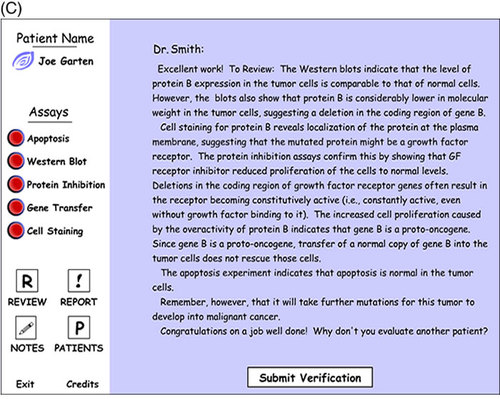
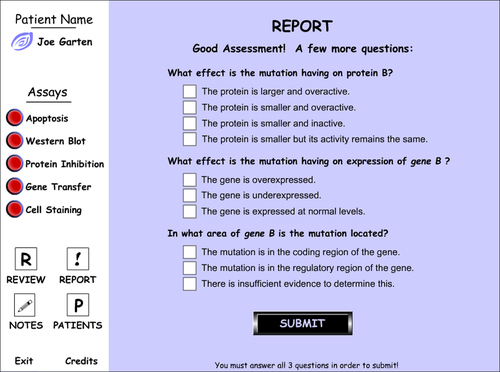
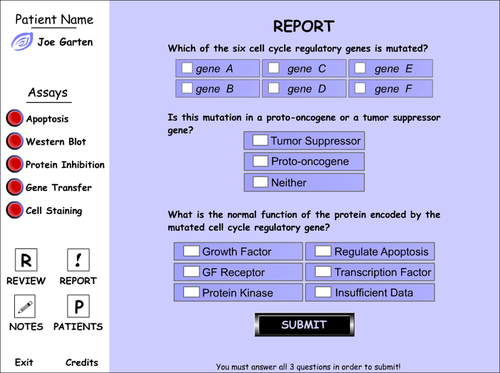
Student Engagement
The extent to which students were engaged in the module was inferred from the time that they reported spending on the module. Twenty-three of the 24 students reported spending at least half an hour on the module. Of those, half of the students spent at least 1 h on the module and the other half spent up to 2.5 h. With half of the students spending an hour or more, it appears that the module was effective at engagement.
To begin assessing the extent to which students explored the module, as well as their success, they were asked how many patients they evaluated. Fifteen students reported exploring two patients, six reported three patients, and one reported four. Only two students reported evaluating just one patient. The students were then asked how many patients they completed, determined by reaching the congratulatory screen. Three students reported completing one case, 14 reported completing two, and 1 reported completing four. Five students reported that they were unable to complete a case and one did not answer the question. With students investigating many patient cases, and over half completing two cases, these responses suggest that the students were effectively engaged in the module and able to complete a diagnosis successfully.
Overall Design
To ascertain how students viewed the module in terms that they use to evaluate teaching and learning, they were given a list of descriptive terms to characterize the module (Table 1). The majority of the students described the activity as challenging and interesting, while a number of responses were also recorded for relevant, cool, fun, intuitive, and easy to navigate.
| In general, how would you describe Cancer Cell Biology? (Please check all that apply) | Students responding |
|---|---|
| Boring | 1 |
| Challenging | 15 |
| Cool | 5 |
| Easy | 1 |
| Extremely difficult | 3 |
| Fun | 4 |
| Interesting | 17 |
| Relevant | 9 |
| Too much information | 0 |
| Too little information | 1 |
| The right amount of information | 2 |
| Intuitive and easy to navigate | 5 |
| Difficult to navigate | 0 |
To gain additional information, the students were asked a series of open-ended questions about what they liked most, liked least, and would change about the module and/or wished it could do. Responses were categorized and tabulated, with representative student answers listed in Table 2. While we expected that students would like the cancer topic, the use of technology to learn, and the role play as doctor/scientist, we did not anticipate that they would like as much as they did the challenge and process of applying their knowledge and data analysis skills. Their enjoyment at conducting the experiments and being rewarded when getting the right answers was an additional unanticipated outcome. Other positive responses included the interactivity and ease of navigation. Reflecting on the culture of today's youth, the overall positive student responses to Cancer Cell Biology could be rooted in this generation growing up with video games and computers. It is within this world that this “technology generation” enjoys thinking, solving problems, and being engaged. The module has presented them a science topic in that world.
| Questiona | Times mentionedb | Example student statementc |
|---|---|---|
| 1. What did you like most about Cancer Cell Biology?a | ||
| Interesting and learned about cancer and assay-related subjects | 5 | “I liked most that there was an activity to perform on to kind of get an understanding of cancer.” |
| Challenging/application of knowledge | 4 | “Just the way it was set up and how it really challenged me to think and apply previous knowledge about interpreting data.” |
| Animations/technology used | 4 | “The animation, the option of having different proteins to choose from and the effects of each technique.” |
| Doing the experiments and finding the right answer | 3 | “Finding the right answer after evaluating the various clues.” |
| Role of doctor/scientist | 3 | “I got the chance to play the role of a scientist trying to figure out a particular problem or a doctor coming up with a diagnosis.” |
| Ease of navigation/interactivity | 3 | “I liked it because it was very interactive and amazingly easy to use. I will recommend it to my colleagues who are not in my class.” |
| 2. What did you like least about Cancer Cell Biology? | ||
| Nothing (they liked it) | 6 | “Nothing really stood out that I did not like.” |
| Too much information/information hard to understand or confusing | 6 | “Too much info required to evaluate a cancer patient and how cancer works.” |
| Data interpretation | 3 | “It was hard to interpret some of the data.” |
| Could not figure out the answer/not enough feedback | 2 | “I didn't like the fact that when you could not figure out an answer there was no alternative besides getting it right, going back to review which basically starts you over from the beginning, or just simply not doing it. There should be an option that allows you to view the answers and brief explanation when they are too tough to figure out.” |
| Took too much time | 2 | “It took too long to complete.” |
| 3. What would you like to see changed about Cancer Cell Biology and/or what do you wish it could do? | ||
| Nothing (liked as is) | 7 | “It is fine the way it is!” |
| More background information on experiments/make easier to understand | 6 | “I would like to see a better explanation of the experiments that were used for the study.” |
| More visual/audio enhancement | 4 | “I'd like to see more computer enhancements in the biology. The movie clips aid as a visual to help the student better understand whats going on with the topic discussed.” |
| Be able to experiment and analyze real cancer cells | 2 | “I would like to get some hands-on experience with actual usage of the items used. Virtual reality is good, but real life is better.” |
Equally important from the standpoint of developers is what the students liked least (Table 2). Interestingly, equal numbers of responses indicated nothing negative to report and that there was too much information or the module was too hard to understand. In addition, some students reported that they liked least 1) the inability to solve the cases despite their best efforts and 2) the need to interpret data. While in the minority, these findings suggest that the module could be improved by providing more information to assist students in solving the cases. Additional student responses involved including more animations, adding audio, and having the module followed by real laboratory experiments, which would indicate a desire to learn more beyond the boundaries of the module.
Student responses to the opportunity to provide any additional feedback on the module that they did not address in previous questions yielded another vantage point from which to assess their impressions of the module. The following comments are representative of this feedback.
“I really enjoyed this program, and I would definitely recommend it to other students who are interested in the medical field.”
“I enjoyed this exercise and feel that it should be regularly be incorporated into all science curricula.”
“I think that the project would work better if we worked in groups.”
“I think that the patient was well covered but prior information about the patient should have been provided like medical history.”
“I think that when completing the report section, hints should be available as to what you are doing wrong.”
“I now wish to learn more about cancer!”
Figure 5. Screen shots of the three-tiered feedback response used to guide students through the report questions. This series of feedback is for the first question in the report which requires students to correctly identify the mutated gene. (A) Shot of the first general feedback suggesting some assays to review. (B) Shot of the second feedback providing additional information, including interpreting results from particular assays. (C) Shot of the third feedback directing the doctor to an experiment(s) critical to making the diagnosis, as well as help with their analysis.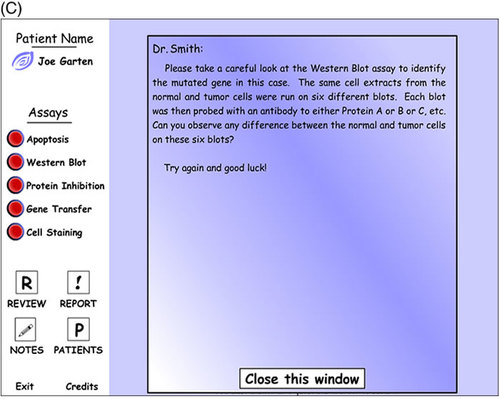
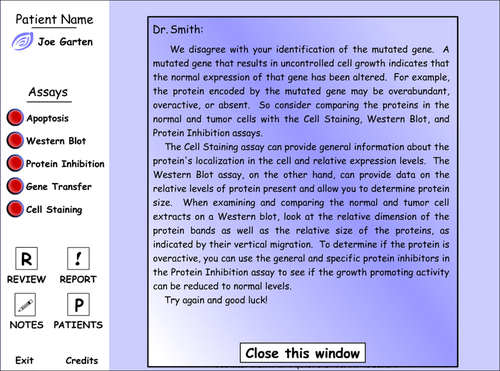
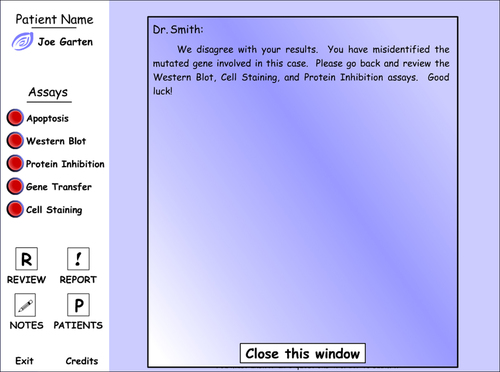
Collectively, the student feedback comments demonstrate that Cancer Cell Biology was an engaging, enjoyable activity that provided new insight into cancer.
MODULE REVISIONS
The combined feedback from scientists/science educators and students, as well as the authors' own observations, identified specific components of this module that needed to be revised to make it a more effective multimedia-based learning environment. The major changes incorporated into the revised version of Cancer Cell Biology (West and Bockholt, 2002) include providing additional information, via both the review and the feedback components, as well as some additional technical improvements.
Protooncogene and Tumor Suppressor Gene Review Component
The review was expanded to include more information and illustrations on how mutations in protooncogenes and tumor suppressor genes result in changes of cell cycle regulation (Figure 3, B and C). With descriptions of how mutations in the coding and regulatory regions affect the expression of the genes, students can“ discover” knowledge in the module to assist them with the completion of the report questions for a patient case.
Report and Instructional Feedback Components
The report and feedback components of the module were revised 1) to minimize further the chance of a diagnosis occurring by guessing—accomplished by providing a minimum of three answers to all questions—and 2) to provide better guided feedback to foster student problem solving and self-discovery.
The feedback was restructured to consist of three levels of hierarchical response for the questions in each question set (Figure 5), replacing the single short feedback message (similar to Figure 5A). Thus, if a student repeatedly answers a question incorrectly, a new, more informative feedback message is given. The first message (Figure 5A) is general and mentions assays that will be helpful in answering the question, which will get the student to reinvestigate assays and think through the solution. Feedback on the second level (Figure 5B) expands upon key concepts and/or how to interpret critical assays, focusing the student's thinking on what needs to be evaluated to determine the solution. Finally, the third level (Figure 5C) guides the student more directly toward making key observations from important assays.
Given this more elaborate feedback structure, attention had to be given to how the multiple-question format would be implemented so that the chances of guessing the correct answers were kept to a minimum. To accomplish this, the feedback component engages only one question at a time, regardless of how many questions the student answers incorrectly. Further, the questions are addressed in the order in which they appear in the report. For example, if a student misses the second and third questions in Figure 4A, feedback would be provided only for the second question, beginning the student's review of content and concepts to submit a revised diagnosis. If, upon resubmission, the student answers the second question correctly, but again misses the third, the student will be informed that the third is incorrect and the feedback process for this question will begin. This design helps students 1) review the case in a progressive fashion, 2) address multiple incorrect answers individually, and 3) identify incorrect answers to subsequent questions during their reevaluation. For example, in the case described above, while seeking the answer for the second question the student might discover that he/she answered the third incorrectly, effectively providing an opportunity for reflection and self-recognition of errors in understanding. Thus, this feedback design maintains the challenging aspects of the module yet provides students additional guidance and information that helps them to be more successful at analyzing a case, thereby encouraging and enabling them to solve more cases.
Technical Improvements
Some of the module's technical improvements required bringing the module's Flash program code up to version 5. Navigation was improved by reprogramming the module to pop out into its own window instead of playing in the Web browser window since navigation is independent of the browser. This feature eliminates the natural tendency to use the browser navigation buttons, which in this case causes the module to restart from the welcoming screen. To make the student notes feature more useful, a print notes button feature was added, which provides a hard copy of the notes for permanent reference. One new feature is the ability of students to submit a verification report when they have completed the analysis of a patient case (Figure 4C). When the student submits the verification, a report is generated and emailed to the instructor. The report (Figure 6) contains 1) the name of the student submitting it, 2) the patient diagnosed, 3) questions from the report screen of that patient, and 4) tracking information indicating the answers the student selected for each submission. Thus, in addition to evaluating student performance, the report provides insight into how a student is progressing with understanding content and biological concepts.
Figure 6. Screen shot of the verification report that the student can send to the instructor. The report is sent to the e-mail address that the student inputs in the module's welcoming screen. Information provided includes the student's name, the patient analyzed, and tracking information on student performance and progress for each submission the student makes to confirm the diagnosis.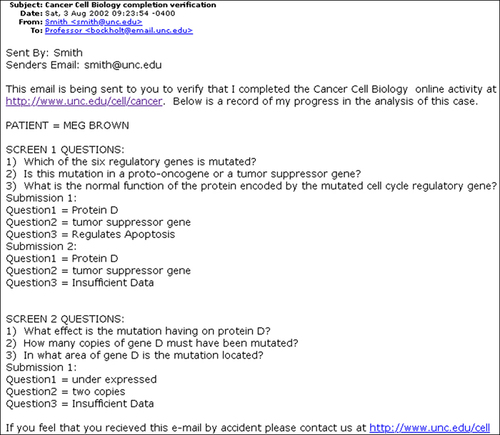
DISCUSSION
Here we have described the development of, and student response to, Cancer Cell Biology, a unique multimedia module that focuses on how mutations in tumor suppressor genes and protooncogenes can lead to cancer.
Using Cancer Cell Biology
This inquiry-based, interactive module was designed to be used in courses that have as prerequisites student understanding of basic cell and molecular biology principles, particularly concepts of gene expression and the cell cycle and some associated experimental techniques. Used toward the end of a semester, it can serve as a way for students to review concepts through a specific topic/application and bridge concepts to experimental techniques, data interpretation, and analysis. How an instructor chooses to implement the module depends upon the instructor's pedagogical approach, goals, and resources; e.g., the module can be assigned to individual or pairs of students either as an in-class or a laboratory activity or as a homework assignment, etc. Further, the instructor can choose to have students submit a verification report via E-mail.
As a teaching tool, Cancer Cell Biology is designed to stimulate student interest and further discussion and exploration on the topic of cancer. Verification reports provide the instructor with information about student performance and progression. Thus, after students complete the module, the instructor is poised to extend cyclical learning in the classroom by using the module as a springboard for student–student discussion of additional follow-up questions, e.g., What known genes could fit the profile of genes identified in the patients?, as well as introducing and/or reinforcing concepts, terminology, and methods, such as 1) genes known to play roles in different cancers, e.g., bcl-2, p53, ras and HER2; 2) the concept that cancer is an accumulation of multiple gene mutations; 3) methods of cancer detection; and 4) the implications of multiple gene mutations for the design of effective cancer treatment therapies. Additional suggestions and details for instructors can be found on an accompanying Web page (Bockholt et al., 2002), where instructors are requested to provide feedback so we can share best practices in using the module broadly.
To elaborate on the cancer topic, there are a few other multimedia tools available. To provide students a different perspective on the disease state, another multimedia tool that consists of an open-ended simulation of breast cancer cases could be utilized (Lundeberg et al., 2002). It focuses on human genetics and includes techniques such as PCR, DNA digest, and Southern blotting to investigate a variety of diseases. This simulation is developed in considerable breadth and depth and consists of an intricate and complex user interface. The CD-ROMs that accompany some textbooks also cover aspects of cancer (Cooper, 1997; Alberts et al., 2002; Karp, 2002), though they are presentation-oriented, with drill/practice questions and answers, emphasizing fact memorization rather than problem-solving skills.
Simulating the Research Process and Conveying Complex Biological Concepts
Interactive multimedia has the potential to create student learning experiences to facilitate the understanding of the scientific process and biological concepts that cannot be achieved with the same information on paper or in lecture. Cancer Cell Biology develops this potential by going beyond creating “shovelware,” i.e., the transfer of one medium to another without taking advantage of the medium to do more (Fraser, 1999). For example, drill/practice and tutorial programs do not substantially change the way in which students interact with knowledge and therefore do not contribute to creating new ways to attach meaning to concepts (Bottino, 2001).
While simplified, Cancer Cell Biology enables students to play the role of scientists performing experiments independently, analyzing their findings, and exploring existing knowledge and data to solve problems, providing a dynamic snapshot of the scientific process. Through its visual capacity and experiential power, Cancer Cell Biology takes advantage of multimedia to convey complex biological concepts. In addition, interactive problem-solving, evaluation, and feedback have been integrated for students to self-identify gaps in their understanding.
Undeniably, hands-on student research gives students the opportunity to learn both concepts and the scientific process in an active, inquiry-based approach. While this may be preferable to most simulations, it is not always feasible or practical. Simulating reality in its entirety while meeting educational goals and assessment needs can be difficult, however, as software evolves and the cost of production decreases, multimedia will be able to provide an even richer environment for science teaching and learning through simulation with advances in both three-dimensional multimedia and, in the future, virtual reality. Virtual reality promises to provide students the ideal simulation of the biological world and access to understanding the underlying concepts by adding the full body–mind kinesthetic dimension to participating in the scientific process (William et al., 1998). The extent to which “virtuality” can be achieved with current educational multimedia is largely dependent upon the time required for development and the cost weighed against the benefits. However, the decision to make use of these technologies will also be determined by the topic, state of the technology's development, learning goals, and limitations for dissemination and adoption. For now, current multimedia tools and designs can be used to create constructivist frameworks that begin to immerse students in environments with limited virtuality involving visual, aural, and textual representation of information (Harper et al., 2000).
Higher-Order Thinking Skills
One goal of science education reform is to shift from lower-order thinking to higher-order thinking and learning skills (Kronberg and Griffin, 2000; Zoller, 2000). Multimedia educational tools often do not allow students to develop higher-order thinking skills, especially those that focus upon drill and practice. Stoney and Oliver (1999) have asserted that in order to use interactive multimedia in a way that encourages higher-order thinking skills, one must depart from sequentially dispensing knowledge and engage students in an applied setting. This enables them to reflect on their learning and incorporate it with their preexisting knowledge. Further, by providing potentially conflicting information, the student must resolve this situation by sifting information, experimenting, and thinking strategically and critically. Further, these learner-centered microworlds allow the student to assume an active role, constructing learning according to needs, preferences, and personal paths (Bottino, 2001). In Cancer Cell Biology, cognitive engagement is supported on numerous levels through its intrinsic design: 1) topic relevancy; 2) nonlinearity; 3) the overall problem-solving scheme requiring a patient diagnosis; 4) critical decision-making in the experimental assays; and 5) reflection and reanalysis when students report an incorrect diagnosis and must go back through the case to locate the origin(s) of their error(s) in reasoning.
Module Development and Pedagogy
We have described how this module was designed primarily by using the 5E model, which has many characteristics in common with multimedia instructional design principles, including the aim to engage, encourage exploration, and provide feedback with evaluation. Lavoie (1995) describes an instructional framework for implementing multimedia using a four-phase learning cycle (hypothetico–predictive, exploration, term introduction, and concept application) as the first of three design levels. The second level addresses instructional design principles, while the third level addresses the first two levels in the context of interactive videodisc instruction. Lavoie's four-phase learning cycle and Bybee's (1997) 5E model are similar because they both have roots in the three-phase Atkin/Karplus learning cycle (exploration, term introduction, and concept applications). The main difference between these instructional models is the emphasis that the 5E model places upon engaging students and evaluating their understanding as a key part of the inquiry instructional model. In light of these similarities, taking the straightforward 5E model and merging it with multimedia instructional design principles should yield a cognitively engaging, interactive multimedia-based learning environment and a unique“ multimedia pedagogy” for science education.
Summary
Cancer Cell Biology illustrates the potential of multimedia in facilitating student learning of biological topics. The medium is able to present learning in ways that are responsive to different learning styles and to the most effective pedagogies for learning science. In addition, the module can provide students some exposure to the research process, especially where it may be unavailable due to limited resources and infrastructure.
For the authors of this report, the development of Cancer Cell Biology has laid a design foundation for the development of future multimedia modules to address important design and pedagogical questions by assessing the impact upon both teaching and learning. As teaching and learning methods co-evolve with technology, several questions emerge as to how best to support teaching and learning with multimedia, including 1) How can a multimedia learning environment provide an intellectual snapshot of the research process? 2) How can multimedia enable understanding of complex biological concepts? 3) How can inquiry learning principles (pedagogy) be adapted to multimedia-based learning environments? and 4) How can self-directed learning experiences using multimedia develop higher-order thinking skills? The answers to these questions will come only after considerable experimentation and assessment with multimedia on a variety of topics and designs. Nonetheless, the time has come for science education to engage multimedia-based learning and explore its potential.
ACKNOWLEDGMENTS
This work was supported by grants to W.E. Bollenbacher from Howard Hughes Medical Institute and Ortho-Clinical Diagnostics.


